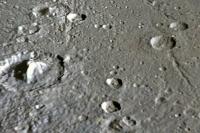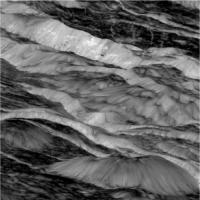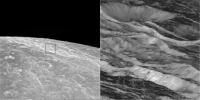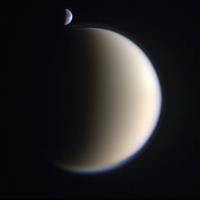Printable Version of Topic
Click here to view this topic in its original format
Unmanned Spaceflight.com _ Cassini's ongoing mission and raw images _ Rev 129 - Mar 29-Apr 17, 2010 - Dione D2
Posted by: DrShank Apr 6 2010, 04:38 PM
Cassini's second hyperclose pass of Dione is just days away. Ive posted some new views and thoughts about Dione
on FB and YT (links below) of some of the features that might be visible in the images, which will show mostly the leading
hemisphere. Jeff Moore and I have been working on a volcanic hypothesis for the smooth plains and the odd features found within
it, which we hope to submit for publication very soon.
images-
http://www.facebook.com/paul.schenk?ref=profile
http://stereomoons.blogspot.com/
movie -
http://www.youtube.com/user/galsat400
Posted by: MahFL Apr 6 2010, 04:49 PM
I can't use FB and You Tube at work......
Posted by: elakdawalla Apr 6 2010, 05:33 PM
We'll you'll either have to quit your job or just wait till you get home to look at that stuff then!
Thanks for the links, Paul. Looking forward to the flyby!
Posted by: Bjorn Jonsson Apr 8 2010, 03:57 PM
Images from the Dione flyby are starting to show up even though some of the image links at the Cassini website are broken. Some semi-random examples:
http://saturn.jpl.nasa.gov/photos/raw/rawimagedetails/index.cfm?imageID=215456
http://saturn.jpl.nasa.gov/photos/raw/rawimagedetails/index.cfm?imageID=215471
http://saturn.jpl.nasa.gov/photos/raw/rawimagedetails/index.cfm?imageID=215449
Interesting fractures and linear features - I doubt the horizontal lines are real but don't have time for detailed inspection of the images now:
http://saturn.jpl.nasa.gov/photos/raw/rawimagedetails/index.cfm?imageID=215441
More bright fractures:
http://saturn.jpl.nasa.gov/photos/raw/rawimagedetails/index.cfm?imageID=215427
This is surely not Saturn as the image caption states:
http://saturn.jpl.nasa.gov/photos/raw/rawimagedetails/index.cfm?imageID=215391
And not this one either:
http://saturn.jpl.nasa.gov/photos/raw/rawimagedetails/index.cfm?imageID=215388
Posted by: john_s Apr 8 2010, 04:22 PM
The Dione images labeled "Saturn" are taken during closest approach, from a range of a few 100 km- the spacecraft was in a fixed attitude to measure particles and fields, but we were able to arrange it so the fields of view of the cameras and other remote sensing instruments were dragged across the disk of Dione during the passage. That explains why some of the NACs are blurred- the spacecraft was not tracking Dione, and we were very close.
John
Posted by: Stu Apr 8 2010, 05:24 PM
Good grief...
http://saturn.jpl.nasa.gov/photos/raw/rawimagedetails/index.cfm?imageID=215529
Posted by: Phil Stooke Apr 8 2010, 05:33 PM
Yikes, I hope it doesn't fall off...
Some nice pics of Janus and Epimetheus on this periapsis too.
Phil
Posted by: Stu Apr 8 2010, 05:48 PM
Oh boy...
http://saturn.jpl.nasa.gov/photos/raw/rawimagedetails/index.cfm?imageID=215391
![]()
Posted by: Hungry4info Apr 8 2010, 05:50 PM
Yes, Bjorn pointed that out.
Is it an icy cliff? Or the wall of a crater?
Posted by: ugordan Apr 8 2010, 05:54 PM
Reminds me of http://www.youtube.com/watch?v=skb2gKR7rOk.
Posted by: Phil Stooke Apr 8 2010, 06:29 PM
"Is it an icy cliff? Or the wall of a crater? "
Both. If you turn it upside down it's easier to interpret. It's an oblique view across fractured terrain and a crater.
Phil
Posted by: lyford Apr 9 2010, 12:26 AM
Oh wow..... wow.... wow.... ![]()
Posted by: nprev Apr 9 2010, 12:45 AM
![]() ...yeah, what Lyford said!
...yeah, what Lyford said!
This one's really giving me a 'what the hell?!' feeling like the early encounters of other moons. I don't even wanna speculate about what exactly we're looking at; need context.
Posted by: Hungry4info Apr 9 2010, 01:53 AM
Ahhh.... that did help.
Posted by: nprev Apr 9 2010, 02:23 AM
That's a little better. There are still some very puzzling small-scale features, though, and it does give the impression of relative youth to me.
Posted by: ElkGroveDan Apr 9 2010, 03:19 AM
This is a common problem with images that come through Canberra, they wind up upside down. Here it is rotated 180.
Posted by: Phil Stooke Apr 9 2010, 03:35 AM
Bonzer! (hey, where's my Barry McKenzie dictionary?)
Phil
Posted by: Juramike Apr 9 2010, 03:48 AM
Cool!
Bright short wavy fractures, bright icy-cliffed craters and long straight lineaments.
This recent image of Dione: http://saturn.jpl.nasa.gov/multimedia/images/raw/casJPGFullS59/W00063496.jpg
Looks real similar to features on Rhea:
fractures/bright crater on Rhea: http://www.flickr.com/photos/31678681@N07/4123921310/in/set-72157622089931268/
long lineaments on Rhea: http://www.flickr.com/photos/31678681@N07/4123997298/in/set-72157622089931268/
Note how the lineament on Dione cuts right through the crater, but seems offset. Perspective due to depth?
Maybe it prexisted before the crater formed?
Posted by: JohnVV Apr 10 2010, 06:47 AM
that is starting to look like what i am getting in blender
N1481738274_4.img
[attachment=21349:Screenshot_1.png]
or should i say I am getting close to Cassini
Posted by: Astro0 Apr 10 2010, 07:02 AM
EGD: This is a common problem with images that come through Canberra, they wind up upside down.
Nah, we get 'em the right way up, we just turn them upsidedown to confuse you northeners ![]()
Had to play with this lovely view of Dione.
A blending of images W00063488 and W00063489 with a touch of colour for effect. ![]()
Posted by: Exploitcorporations Apr 10 2010, 08:49 AM
That's a keeper, Astro0!
The oblique view of the tectonic cliffs has to be one of the classic images from this mission. Absolutely jaw-dropping, and a human-scale landscape to boot. I expect to see this one widely published for years to come.
Posted by: john_s Apr 10 2010, 02:36 PM
Note that there is context for most or all of the highest-res NAC images taken during the "ORS Drag" at closest approach (the ones labeled "Saturn") - there are simultaneous WACs, though they are not next to each other on the raw image pages so you have to look around to match them up.
John
Posted by: Floyd Apr 10 2010, 04:22 PM
Wow--that does help. Thanks John and Gordan.
Posted by: ugordan Apr 10 2010, 04:25 PM
Another pair, also rotated 180 deg, to make illumination come from "above":
That looks like a much higher resolution shot than above.
Posted by: Phil Stooke Apr 10 2010, 06:06 PM
Wow, look at the very narrow fractures in the highest resolution shot. They would be completely unexpected based on the other image alone, even though that looks like it's "very high resolution" itself. Now we need a context image for the first one!
Phil
Posted by: john_s Apr 10 2010, 06:36 PM
The scale on that NAC image is about 6 meters/pixel, though smear and noise make the resolution worse than that. So the fracture is really tiny- something like 50 meters wide.
John
Posted by: ugordan Apr 10 2010, 06:40 PM
It's fractures all the way down to the resolution limit, baby!
Posted by: nprev Apr 12 2010, 01:16 AM
Belated thanks as well, John & Gordan!
Interesting observation as well, Gordan: "...fractures all the way down to the resolution limit..." Hmm.
Occurs to me that such widespread fracturing could vastly increase the total amount of Dione's surface area to space & radiation. Could sputtering alone explain Dione's apparent low-level outgassing?
Posted by: jekbradbury Apr 12 2010, 01:35 AM
Radiationwise, the surface area of a given body is always the same: the area subtended by the body from the perspective of an observer at a distance of infinity in the direction the radiation is coming from. That is, there is no possible path of an incoming ray that would hit the surface of a highly-fractured Dione but not a smooth Dione. The same argument applies to cratering. However, that doesn't mean there aren't other reasons why a high surface area could increase outgassing - but it's unlikely that such a property could actually cause outgassing that would not otherwise occur at all.
Posted by: stevesliva Apr 12 2010, 02:34 AM
And if Dione is reflective?
Posted by: Hungry4info Apr 13 2010, 04:41 PM
Same response.
Even if Dione is reflective, only the surface in our line of sight can reflect particles toward us.
Posted by: dilo Apr 28 2010, 05:03 AM
April, 20 view (N00153311/12/13-RGB filters-motion compensated):
Powered by Invision Power Board (http://www.invisionboard.com)
© Invision Power Services (http://www.invisionpower.com)







